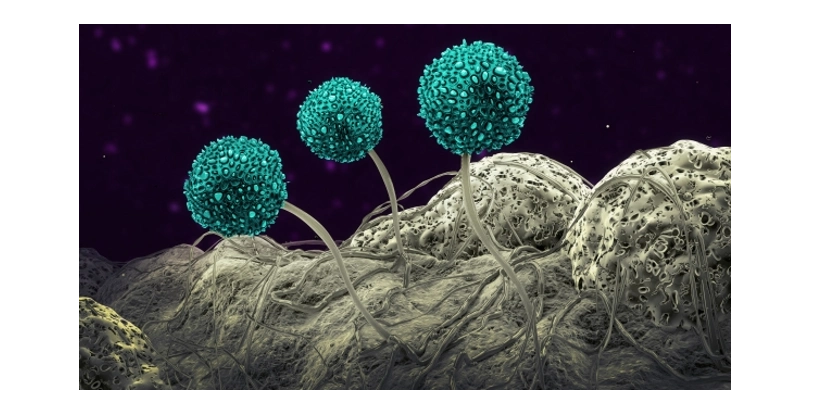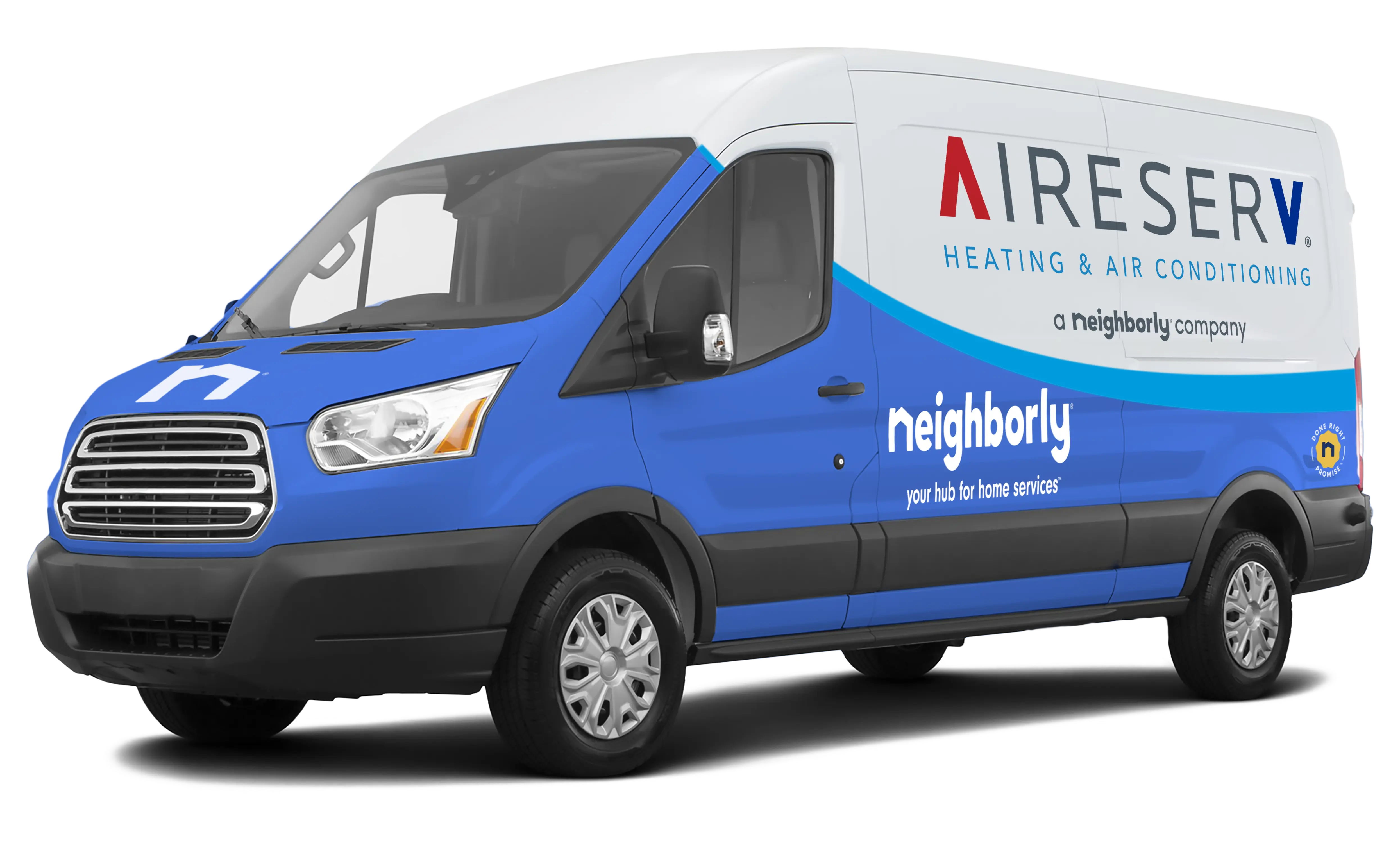
Aire Serv outlines effective ways to eliminate airborne mold spores and improve indoor air quality.
- Identify and fix moisture sources to prevent mold growth
- Use HEPA air purifiers to capture spores
- Regularly clean and vacuum with HEPA filters
- Maintain proper ventilation throughout your home
Is there a musty smell lingering in your home? Are you experiencing a constant runny nose or throat irritation? These are common symptoms of airborne allergens, specifically mold spores—a dangerous loiterer to have in your home. Fortunately, you can take steps to reduce their occurrence and stop their spread before they become a live-in roommate.
What Causes Mold Spores in the Air?
Mold naturally lives in our environment but specifically thrives and grows in damp places. A plethora of airborne mold spores in your home is certainly the result of some kind of moisture issue, such as:
- Roof or internal plumbing leaks
- Poor outdoor drainage
- Poor indoor air circulation
- High indoor humidity
- Improper ventilation
- Malfunctioning HVAC system
How Long Do Mold Spores Stay in the Air?
Unfortunately, mold spores can remain airborne indefinitely, especially when mold is present, not fully removed, or disturbed in your home. And even if mold is not currently present in your home, mold spores can travel long distances—attaching to you or pets or entering through ventilation. Once inside, they can quickly spread and latch on in unattended damp areas.
Because there are so many opportunities for mold growth in your home between your HVAC systems, ventilation, plumbing, and even outdoor maintenance, regularly inspecting for mold is vital. Maintaining proper air circulation and inspecting air quality will also help to minimize the potential for lingering mold spores.
How to Get Rid of Mold Spores in Your House
As a natural and important aspect of our environment, mold spores cannot be fully eliminated from inside your home. However, they aren’t a health hazard until they begin to amply spread and grow into mold. That’s why if you have a mold spore issue, you likely have a moisture issue, an ideal environment for harmful amounts of mold to begin growing. So, to remove this hazard from your home, you’ll need to tackle the root of the problem as well.
To get rid of the majority of excess mold spores:
- Install an Air Purifier: Using an air purifier to remove mold spores in the air is one of the best ways to initially get the problem under control because they work by capturing and removing harmful pollutants in your home. However, you shouldn’t rely on this alone to fully eliminate spores when they can remain in filters, depending on the severity of the spore amount.
- Ventilate your home: Keep your home properly ventilated by allowing fresh air in occasionally and making sure that humid areas (kitchen, bathroom, basement, and attic) have proper fan ventilation.
- Replace HVAC filters with higher efficiency ones (HEPA): Unlike most HVAC filters, HEPA filters are designed to capture much smaller pollutants like mold spores and can be a much safer option for those who struggle with respiratory issues. However, because they more heavily restrict airflow, your system should be checked for compatibility.
To tackle the root of mold growth and prevent spores from spreading:
- Get a dehumidifier: It’s possible that despite proper ventilation, there is still a lot of natural humidity in your home. A great way to control this issue is with a dehumidifier. This will help keep your humidity levels at a controlled percentage.
- Inspect and clean your air ducts: Incorrect duct sizing or buildup from lack of cleaning can lead to trapped moisture and blockage. Get your ducts inspected, and schedule regular duct cleaning to avoid attracting mold.
- Inspect plumbing and your exterior for leaks: Plumbing leaks can be hard to spot if they’re located in less-visited or even hidden areas of your home—unattended they can lead to a lot of damage and mold growth. It’s also important to maintain the exterior for improper drainage or leaks that will surround your home and lead any mold growth to eventually enter and find other sources of moisture.
Related Topic: How to Improve Indoor Air Quality
Stop the Spread of Mold Spores with Expert Air Purification Services
The bottom line is that to deal with the spread of airborne mold spores; you need to address the root of the problem: excessive moisture. Doing so will remove the hazard of mold and create a more comfortable and efficient home environment. To get started, contact your local Aire Serv for mold spore control. Our Air Purification installation services can help reduce and control humidity and improve the indoor air quality in your home. Give us a call us, or request an appointment online today.
This article is intended for general informational purposes only and may not be applicable to every situation. You are responsible for determining the proper course of action for your home and property. Aire Serv is not responsible for any damages that occur as a result of this blog content or your actions. For the most accurate guidance, contact the Aire Serv location nearest you for a comprehensive, on-site assessment.
FAQs About Mold Spores in Your Home or Business
As an industry leader and a brand that is trusted by homeowners and businesses nationwide for our knowledge and experience, we’re happy to answer your HVAC questions. Here are answers to some of the frequently asked questions about mold spores in the air.
What kills mold spores in the air?
Several methods can effectively kill mold spores in the air. HEPA air purifiers are excellent at trapping airborne spores as they pass through the filter. UV-C light, especially when integrated into HVAC systems or used as a standalone device, disrupts the DNA of mold spores, rendering them unable to reproduce. Additionally, spraying a solution of equal parts vinegar and water or a diluted hydrogen peroxide solution into the air can help to kill airborne mold spores.
How long do mold spores live?
Mold spores can remain viable for years in dry conditions by entering a dormant state. They are remarkably resilient and don't truly “die” until they are completely removed. While dry conditions prevent growth and reproduction, the spores can reactivate and colonize in 24 to 48 hours once moisture is reintroduced.
Factors influencing how long mold spores live without moisture include the specific mold species, environmental conditions like temperature and humidity, and the availability of nutrients. Therefore, simply drying out the mold is insufficient; thorough cleaning and controlling moisture are important to prevent regrowth.
Do mold spores float in the air?
Yes, mold spores easily float through air currents. They are incredibly tiny, typically ranging from 2 to 100 microns in size—much smaller than the width of a human hair—which allows them to become airborne.
Like dandelion seeds carried by the wind, mold spores are readily dispersed throughout indoor and outdoor environments. Everyday activities like walking, vacuuming, or even a gentle breeze can disturb mold colonies, releasing countless spores into the air. These spores can remain suspended for extended periods until they land on a suitable surface with moisture and nutrients, allowing them to begin new growth.
To address airborne mold spores in your home, consult a residential air quality professional.
Is black mold airborne?
Yes, the spores of black mold (Stachybotrys chartarum) can and do become airborne. These microscopic spores are easily released when mold colonies are disturbed, even by simple actions like walking past or cleaning.
While black mold spores themselves are not uniquely more dangerous than other mold spores, they can still trigger allergic reactions in sensitive individuals, leading to symptoms such as coughing, sneezing, and eye irritation. In some cases, exposure to mold, including black mold, can worsen asthma symptoms. Furthermore, disturbed black mold can release tiny mold fragments and potentially mycotoxins into the air, which can be inhaled.
Address any black mold growth promptly to minimize the release of airborne spores and potential health risks.
Can mold ever be fully removed?
While it's practically impossible to eliminate all mold spores from an environment due to their ubiquitous presence, active mold growth can be effectively removed and controlled through proper remediation.
Complete spore removal, in the sense of creating a sterile, mold-free environment, isn't achievable or necessary. The goal of professional mold remediation is to identify and eliminate the moisture source fueling the growth, physically remove the mold-damaged materials or clean the affected surfaces, and prevent future growth. This process aims to bring mold spore levels back to a normal, safe range.
Here's how mold is addressed:
- Identify and eliminate moisture sources: This is the most critical step. Without fixing leaks, condensation, or humidity issues, mold will inevitably return.
- Containment: Isolating the affected area prevents the spread of spores to unaffected parts of the building. Containment often involves sealing off rooms with plastic sheeting and using negative air pressure.
- Physical removal: Moldy porous materials like drywall, carpet, insulation, and ceiling tiles must be removed and disposed of properly.
- Cleaning and disinfecting: Non-porous surfaces are scrubbed with antimicrobial solutions to kill mold and spores. HEPA vacuums are used to capture airborne spores and debris.
- Drying: Thoroughly drying the cleaned areas prevents regrowth. Dehumidifiers and fans are often employed.
- Encapsulation (sometimes): In some cases, after cleaning, a sealant or paint-like substance is applied to make remaining mold inactive and prevent moisture penetration.
- Post-remediation testing: Professionals may conduct air quality tests to ensure the remediation was successful and spore levels are within acceptable limits.
To learn more about how to get rid of mold in your attic, mold in air ducts, or elsewhere in your home or business, contact a mold remediation professional.
Does an air purifier help with mold?
Yes, an air purifier can help with mold by capturing airborne mold spores. The most effective type for this purpose is a HEPA (High-Efficiency Particulate Air) filter air purifier. HEPA filters are designed to trap 99.97% of particles as small as 0.3 microns. Since mold spores typically range from 1 to 20 microns, a good HEPA filter can significantly reduce the number of circulating spores.
However, it's important to understand that an air purifier only addresses airborne spores. It does not eliminate existing mold growth on surfaces or address the underlying moisture issues that cause mold in the first place. Therefore, while an air purifier can be a helpful tool in improving air quality and reducing the spread of airborne mold spores, it should be used in conjunction with proper mold remediation and moisture control.
To assess the quality of your air or establish a proactive defense against airborne mold spores, consult an indoor air quality professional.
How do you get rid of mold spores in an office?
A commercial air quality professional can help you reduce mold spores and prevent future growth through several key services:
- Air duct cleaning: Mold spores can accumulate in your HVAC ductwork. A service professional can clean your air ducts, removing dust, debris, and mold spores that may circulate through your business when your system runs.
- Air purifier installation: A professional can install air purifiers that integrate with your HVAC system. These purifiers often use HEPA filters and/or UV-C light technology to capture and kill airborne mold spores as they pass through the system.
- HVAC system maintenance: Regular HVAC maintenance can help prevent mold growth. Professionals can inspect for moisture issues (such as condensation), ensure proper drainage, and clean components where mold might thrive. Addressing these issues early can prevent mold spores from being distributed throughout your business.
- Humidity control: High humidity levels encourage mold growth. Service professionals can assess the relative humidity and recommend solutions to help maintain optimal humidity levels and prevent mold spore proliferation.
- Air filter replacement: Regularly replacing your HVAC air filters is important. A professional can ensure you have the correct high-efficiency filters and help you establish a maintenance schedule to trap airborne particles, including some mold spores.
- UV light installation: A service professional can install UV-C lights within your HVAC system. As air passes by these lights, the UV-C radiation kills or neutralizes mold spores and other microorganisms.
How do you prevent mold in a humidifier?
These strategies can help prevent mold growth in your humidifier:
- Tea tree oil: Adding a few drops of tea tree oil to the water in your humidifier can help prevent mold growth. Tea tree oil possesses natural antifungal properties that make it effective for mold prevention. However, be cautious if you have pets, as tea tree oil can be toxic to animals in high concentrations.
- Humidifier tablets: Humidifier tablets are specifically designed to reduce mold and lime buildup. Simply drop a tablet into the water reservoir, and it will help control mold growth.
- Hydrogen peroxide or vinegar: Both hydrogen peroxide and vinegar can kill bacteria and mold. Adding a few drops of hydrogen peroxide or one cup of vinegar to the water can help maintain a clean and mold-free humidifier.
- Regular cleaning and maintenance: In addition to these additives, it's crucial to clean your humidifier regularly. Empty the water tank daily and perform a thorough cleaning with mild soap and water to remove any potential mold buildup.

